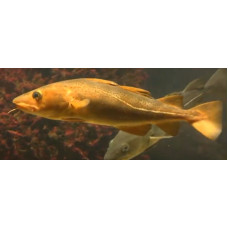Atlantic cod (Gadus morhua) is a marine fish of the cod family. Body length up to 170 cm, weight up to 40 kg. The mouth is large, with a tendril on the chin. Three spiny fins and 2 anal fins. Inhabits the northern part of the Pacific and Atlantic Oceans. Forms several subspecies and herds. Marine gregarious fish. Leads a pelagic lifestyle. Makes long migrations. Spawning from February to June at a water temperature of 4-6 ° C. Hatch from 2.5 to 10 million pelagic spherical eggs. The gregarious predator eats small fish. Valuable commercial fish.
Atlantic cod is found from the coastal strip to the continental shelf, but rarely in the open sea above deep water. Its life cycle is tied to the sea currents of the North Atlantic.
Atlantic cod breed off the coast of Norway and feed in the Barents Sea and shallow waters off Svalbard. The main spawning grounds for this fish are off the Lofoten Islands (Norway). Spawning takes place in March-April at depths of up to 100 meters, at the border of warm Atlantic waters and colder fjord waters. Fertilized eggs are picked up by the current, which carries them northward. The hatched larvae feed on plankton. Some of the juveniles are carried by the current to Medvezhie Island, but a large number are brought into the Barents Sea by the Nordkapp Current. By July, fry drifting northward reach 72-73°N, and those drifting eastward reach the Kola meridian (33°E). In September, juveniles reach the eastern Barents Sea, where they switch to a bottom-dwelling lifestyle. During the first two years of life, juvenile cod feed on small crustaceans.
From the age of 3 years cod becomes a predator and begins to make noticeable migrations. Three species of plankton-eating fish - herring (usually juveniles), capelin and saika - form the basis of cod feeding in the Barents Sea. In summer, cod often feeds on crustaceans of the family Euphausiaceae; sometimes it eats bottom fauna, usually bivalves, from which it bites off the legs they extend. It also feeds on its own young and smaller congeners.
At the age of 8-9 years, having reached a weight of 3-4 kg, Atlantic cod for the first time goes to spawn. In September-October it gathers in large flocks and begins its migration back to the Lofoten Islands. This route, which is more than 1500 km long, it passes for 5-6 months with an average speed of 7-8 km per day. Females stay on the spawning ground for several weeks, hatching 2-3 portions of eggs; males stay the same length of time, fertilizing females. Spawned individuals return to the feeding grounds to fatten up. Some subspecies (White Sea, Baltic) cod have adapted to life in freshened seas, do not make long-distance migrations and mature earlier, at 3-4 years of life.
Atlantic cod
Tags: atlantic cod



